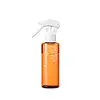What's inside
What's inside
 Key Ingredients
Key Ingredients

 Benefits
Benefits

 Concerns
Concerns

 Ingredients Side-by-side
Ingredients Side-by-side

Water
Skin ConditioningAlcohol Denat.
AntimicrobialCetyl Ethylhexanoate
EmollientC12-15 Alkyl Benzoate
AntimicrobialCaprylic/Capric Triglyceride
MaskingTrisiloxane
Skin ConditioningDicaprylyl Carbonate
EmollientParfum
MaskingArgania Spinosa Kernel Oil
EmollientSodium Chloride
MaskingSimmondsia Chinensis Seed Oil
EmollientCocos Nucifera Oil
MaskingEthylhexylglycerin
Skin ConditioningDisodium EDTA
Limonene
PerfumingPrunus Armeniaca Kernel Oil
MaskingOlea Europaea Fruit Oil
MaskingSclerocarya Birrea Seed Oil
HumectantCamellia Japonica Seed Oil
EmollientLinalool
PerfumingCoco-Caprylate/Caprate
EmollientCitronellol
PerfumingGeraniol
PerfumingHydroxycitronellal
PerfumingTocopherol
AntioxidantGlycolipids
Skin ConditioningWater, Alcohol Denat., Cetyl Ethylhexanoate, C12-15 Alkyl Benzoate, Caprylic/Capric Triglyceride, Trisiloxane, Dicaprylyl Carbonate, Parfum, Argania Spinosa Kernel Oil, Sodium Chloride, Simmondsia Chinensis Seed Oil, Cocos Nucifera Oil, Ethylhexylglycerin, Disodium EDTA, Limonene, Prunus Armeniaca Kernel Oil, Olea Europaea Fruit Oil, Sclerocarya Birrea Seed Oil, Camellia Japonica Seed Oil, Linalool, Coco-Caprylate/Caprate, Citronellol, Geraniol, Hydroxycitronellal, Tocopherol, Glycolipids
Water
Skin ConditioningCetearyl Alcohol
EmollientCocos Nucifera Oil
MaskingCetyl Alcohol
EmollientCetyl Esters
EmollientSaccharum Officinarum Extract
MoisturisingCamellia Sinensis Leaf Extract
AntimicrobialPhyllanthus Emblica Fruit Extract
HumectantCitrus Limon Peel Extract
EmollientPyrus Malus Fruit Extract
Skin ConditioningDilauryl Thiodipropionate
AntioxidantNiacinamide
SmoothingLeuconostoc/Radish Root Ferment Filtrate
AntimicrobialTrideceth-6
EmulsifyingAmodimethicone
Behentrimonium Methosulfate
Sodium Hydroxide
BufferingPyridoxine Hcl
Skin ConditioningHydrolyzed Corn Protein
Skin ConditioningHydrolyzed Soy Protein
HumectantHydrolyzed Vegetable Protein Pg-Propyl Silanetriol
Skin ConditioningHydrolyzed Wheat Protein
Skin ConditioningHydroxypropyltrimonium Lemon Protein
HumectantCaprylic/Capric Triglyceride
MaskingCitric Acid
BufferingPotassium Sorbate
PreservativeSalicylic Acid
MaskingPhenoxyethanol
PreservativeCetrimonium Chloride
AntimicrobialCI 15985
Cosmetic ColorantCI 19140
Cosmetic ColorantLinalool
PerfumingAmyl Cinnamal
PerfumingHexyl Cinnamal
PerfumingBenzyl Alcohol
PerfumingParfum
MaskingWater, Cetearyl Alcohol, Cocos Nucifera Oil, Cetyl Alcohol, Cetyl Esters, Saccharum Officinarum Extract, Camellia Sinensis Leaf Extract, Phyllanthus Emblica Fruit Extract, Citrus Limon Peel Extract, Pyrus Malus Fruit Extract, Dilauryl Thiodipropionate, Niacinamide, Leuconostoc/Radish Root Ferment Filtrate, Trideceth-6, Amodimethicone, Behentrimonium Methosulfate, Sodium Hydroxide, Pyridoxine Hcl, Hydrolyzed Corn Protein, Hydrolyzed Soy Protein, Hydrolyzed Vegetable Protein Pg-Propyl Silanetriol, Hydrolyzed Wheat Protein, Hydroxypropyltrimonium Lemon Protein, Caprylic/Capric Triglyceride, Citric Acid, Potassium Sorbate, Salicylic Acid, Phenoxyethanol, Cetrimonium Chloride, CI 15985, CI 19140, Linalool, Amyl Cinnamal, Hexyl Cinnamal, Benzyl Alcohol, Parfum
 Reviews
Reviews

Ingredients Explained
These ingredients are found in both products.
Ingredients higher up in an ingredient list are typically present in a larger amount.
This ingredient is an emollient, solvent, and texture enhancer. It is considered a skin-softener by helping the skin prevent moisture loss.
It helps thicken a product's formula and makes it easier to spread by dissolving clumping compounds.
Caprylic Triglyceride is made by combining glycerin with coconut oil, forming a clear liquid.
While there is an assumption Caprylic Triglyceride can clog pores due to it being derived from coconut oil, there is no research supporting this.
Learn more about Caprylic/Capric TriglycerideCocos Nucifera Oil is obtained from the kernels of the coconut fruit. In other words, this is coconut oil.
Coconut Oil is rich in fatty acids with lauric acid making up the majority of these. It also contains linoleic acid. Due to this high fatty acid content, coconut oil helps trap moisture and soften skin.
Despite being antibacterial, coconut oil may not be great for acne-prone skin. It is comedogenic and may clog pores. This ingredient may not be safe for malassezia or fungal acne.
Note: Coconut Oil should not replace your sunscreen for UV protection. Studies show it only blocks about 20% of UV.
This oil is non-volatile and has a light scent.
The term 'fragrance' is not regulated in many countries. In many cases, it is up to the brand to define this term. For instance, many brands choose to label themselves as "fragrance-free" because they are not using synthetic fragrances. However, their products may still contain ingredients such as essential oils that are considered a fragrance.
Learn more about Cocos Nucifera OilLinalool is a fragrance and helps add scent to products. It's derived from common plants such as cinnamon, mint, citrus, and lavender.
Like Limonene, this ingredient oxidizes when exposed to air. Oxidized linalool can cause allergies and skin sensitivity.
This ingredient has a scent that is floral, spicy tropical, and citrus-like.
Learn more about LinaloolParfum is a catch-all term for an ingredient or more that is used to give a scent to products.
Also called "fragrance", this ingredient can be a blend of hundreds of chemicals or plant oils. This means every product with "fragrance" or "parfum" in the ingredients list is a different mixture.
For instance, Habanolide is a proprietary trade name for a specific aroma chemical. When used as a fragrance ingredient in cosmetics, most aroma chemicals fall under the broad labeling category of “FRAGRANCE” or “PARFUM” according to EU and US regulations.
The term 'parfum' or 'fragrance' is not regulated in many countries. In many cases, it is up to the brand to define this term.
For instance, many brands choose to label themselves as "fragrance-free" because they are not using synthetic fragrances. However, their products may still contain ingredients such as essential oils that are considered a fragrance by INCI standards.
One example is Calendula flower extract. Calendula is an essential oil that still imparts a scent or 'fragrance'.
Depending on the blend, the ingredients in the mixture can cause allergies and sensitivities on the skin. Some ingredients that are known EU allergens include linalool and citronellol.
Parfum can also be used to mask or cover an unpleasant scent.
The bottom line is: not all fragrances/parfum/ingredients are created equally. If you are worried about fragrances, we recommend taking a closer look at an ingredient. And of course, we always recommend speaking with a professional.
Learn more about ParfumWater. It's the most common cosmetic ingredient of all. You'll usually see it at the top of ingredient lists, meaning that it makes up the largest part of the product.
So why is it so popular? Water most often acts as a solvent - this means that it helps dissolve other ingredients into the formulation.
You'll also recognize water as that liquid we all need to stay alive. If you see this, drink a glass of water. Stay hydrated!
Learn more about Water